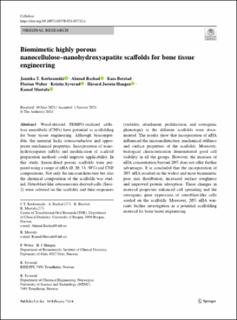| dc.contributor.author | Korkeamäki, Jannika Timontytär | |
| dc.contributor.author | Rashad, Ahmad | |
| dc.contributor.author | Berstad, Kaia | |
| dc.contributor.author | Weber, Florian | |
| dc.contributor.author | Syverud, Kristin | |
| dc.contributor.author | Haugen, Håvard Jostein | |
| dc.contributor.author | Mustafa, Kamal Babikeir Elnour | |
| dc.date.accessioned | 2024-02-27T14:51:04Z | |
| dc.date.available | 2024-02-27T14:51:04Z | |
| dc.date.created | 2024-01-03T11:35:10Z | |
| dc.date.issued | 2024 | |
| dc.identifier.issn | 0969-0239 | |
| dc.identifier.uri | https://hdl.handle.net/11250/3120174 | |
| dc.description.abstract | Wood-derived TEMPO-oxidized cellulose nanofibrils (CNFs) have potential as scaffolding for bone tissue engineering. Although biocompatible, the material lacks osteoconductive and appropriate mechanical properties. Incorporation of nano-hydroxyapatite (nHA) and modification of scaffold preparation methods could improve applicability. In this study, freeze-dried porous scaffolds were prepared using a range of nHA (0, 20, 33, 50%) and CNF compositions. Not only the microarchitecture but also the chemical composition of the scaffolds was studied. Osteoblast-like osteosarcoma derived cells (Saos-2) were cultured on the scaffolds and their responses (viability, attachment, proliferation, and osteogenic phenotype) to the different scaffolds were documented. The results show that incorporation of nHA influenced the microarchitecture, mechanical stiffness and surface properties of the scaffolds. Moreover, biological characterization demonstrated good cell viability in all the groups. However, the increase of nHA concentration beyond 20% does not offer further advantages. It is concluded that the incorporation of 20% nHA resulted in the widest and most biomimetic pore size distribution, increased surface roughness and improved protein adsorption. These changes in material properties enhanced cell spreading and the osteogenic gene expression of osteoblast-like cells seeded on the scaffolds. Moreover, 20% nHA warrants further investigation as a potential scaffolding material for bone tissue engineering. | en_US |
| dc.language.iso | eng | en_US |
| dc.publisher | Springer | en_US |
| dc.rights | Navngivelse 4.0 Internasjonal | * |
| dc.rights.uri | http://creativecommons.org/licenses/by/4.0/deed.no | * |
| dc.title | Biomimetic Highly Porous Nanocellulose-Nanohydroxyapatite Scaffolds for Bone Tissue Engineering | en_US |
| dc.title.alternative | Biomimetic Highly Porous Nanocellulose-Nanohydroxyapatite Scaffolds for Bone Tissue Engineering | en_US |
| dc.type | Peer reviewed | en_US |
| dc.type | Journal article | en_US |
| dc.description.version | publishedVersion | en_US |
| dc.source.journal | Cellulose | en_US |
| dc.identifier.cristin | 2219773 | |
| dc.relation.project | Bergens forskningsstiftelse: BFS2018TMT10 | en_US |
| cristin.ispublished | false | |
| cristin.fulltext | postprint | |
| cristin.qualitycode | 1 | |

